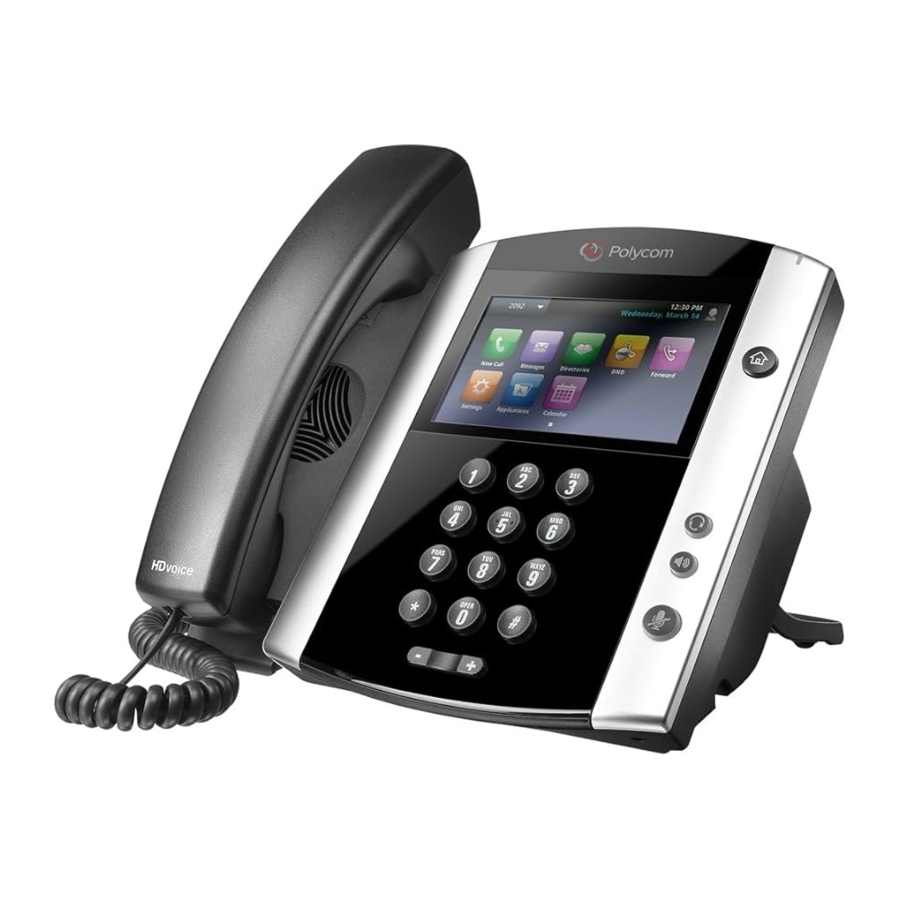
Polycom VVX Series Installation Guide
- User manual (144 pages) ,
- Manual (16 pages) ,
- Regulatory notice (14 pages)
Advertisement

GETTING STARTED
This guide is only intended for installation of IBC Poly devices over a public internet connection, also referred to as over-the-top (OTT).

What you need to get started:
- The Poly VVX Series Set and package contents listed below.
- Set configuration credentials. An email will be sent on the date of your service order from the SaskTel Business Team with a subject line of IBC login and support. Included in this email will be your IBC User ID and password, along with your conference set server user (10-digit phone number) and password. You will need the conference set configuration credentials for this process.
Keep the email for future reference. Contact your Service Representative if you did not receive the email.- If you are configuring two telephone numbers on the device, you will receive two emails; one for the primary telephone number and one for the multiline (secondary) number. You will not need to register the secondary number, this will happen automatically upon registration of the primary telephone number.
- Poly compatible power adaptor, or a network device capable of providing power over ethernet (for instance a switch).
Package contents

Optional accessories

Connect Cables
If you have power over ethernet, a single ethernet cable will provide electrical power and internet to your phone. Otherwise, use the power adaptor along with your ethernet cable. Connect the power cable and insert the ethernet cable into the internet port on the back of the phone. You can share your internet connection with other devices by plugging an ethernet cable into the phone's PC port and the other end into your computer or laptop.

CONNECT OPTIONAL EXPANSION MODULES, HEADSET, OR USB DEVICES
Expansion Modules can be connected to the AUX port from the phone to the module. You can connect up to 3 expansion modules.
Your phone supports wired and may support wireless headsets, including EHS headsets. VVX 601 phones also support Bluetooth headsets. To learn more about compatible headsets for your set, see Compatible Headsets on sasktel.com/ibcsupport.
For connection directions, refer to your headset documentation. Standard headsets typically use the RJ-9 or USB port (only available in VVX 401, 501 or 601), while EHS headsets use the RJ-9 and serial port. The ports are on the back of the phone, as shown below.

CONFIGURING YOUR SET
- Once you have connected to a network and a power source, the phone will upgrade firmware and reboot several times. This could take 5 to 15 minutes. When the phone is ready to continue, it will have a QSetup softkey.
![]()
- Press the QSetup softkey.
- Use the navigation keys to highlight Server User, press the Select button in the center of the navigation key.
- Enter your 10-digit phone number of the primary telephone number, press Select.
![]()
- Us the navigation keys to highlight Server Password, press the Select button.
- Enter the password provided to you in the email from the SaskTel Business Team, press Select.
NOTE: Use the softkey labeled Mode/Encoding to switch the keypad from numbers to letters.
The top line of the display will indicate which mode you are in.
![]()
- Press Exit.
- Press Select to Save Config. After a few seconds, the phone should reboot again. The phone will upgrade firmware and could take 5 to 15 minutes to complete.
- When the phone is ready, you should see your phone extension on the display and a handset icon with a green checkmark. To verify a successful configuration, test an outbound and an inbound call.
![]()
If you experience any issues, please refer to the Troubleshooting Guide on sasktel.com/ibcsupport.
VOIP 9-1-1
Important information regarding emergency calls:
9-1-1 service is available in a non-standard way with SaskTel IBC. The caller's location and telephone number are not automatically transmitted with the 9-1-1 call. The caller must orally provide the information to the operator answering the call. For calls made from within Canada and the United States, an operator will answer the 9-1-1 call, request the caller's telephone number, location and emergency service required and route the call to the public safety answering point serving the location provided by the caller. If the 9-1-1 caller cannot communicate his or her location or when a 9-1-1 call is disconnected before the
9-1-1 caller's location can be determined, and the operator cannot re-establish contact with the caller, SaskTel will use the registered service address to route the call to the appropriate Public Safety Answering Point.
9-1-1 calls made from locations outside of Canada and the United States cannot be completed by the operator. The caller will be told to use an alternate service to place the emergency call.
9-1-1 calling via SaskTel IBC is provided subject to the availability of 9-1-1 service at the customer's physical location. SaskTel IBC, including 9-1-1 dialing, may not function in the event of a power failure or internet service provider service outage or if the account has been suspended or terminated for nonpayment or other permitted reasons.
Service charges ordinarily applicable for service address changes will not be charged as they are required to update the 9-1-1 service address database.
Because the service can be moved temporarily, the customer is required to update their address when using the service somewhere other than the original registered location. Temporary address updates can be made at www.sasktel.com/voip911 using the 10-digit phone number and the same password used for voice mail service. Once submitted, location updates will be made in real time.
Documents / Resources
References
Download manual
Here you can download full pdf version of manual, it may contain additional safety instructions, warranty information, FCC rules, etc.
Advertisement
























Need help?
Do you have a question about the VVX Series and is the answer not in the manual?
Questions and answers